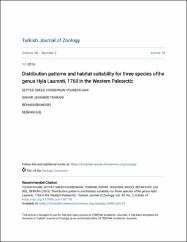Distribution patterns and habitat suitability for three species of the genus Hyla Laurenti, 1768 in the Western Palearctic
Künye
Hosseinian Yousefkhani, S.S., Javaheri Tehrani, S., Moodi, B. & Gul, S. (2016). Distribution patterns and habitat suitability for three species of the genus Hyla Laurenti, 1768 in the Western Palearctic. Turkish Journal of Zoology, 40(2), 257-U173. https://doi.org/10.3906/zoo-1507-38Özet
Hyla is one of the genera in the family Hylidae that is distributed in the Old World. Three tree frog species of this genus are distributed in Eurasia and especially inhabit semiaquatic regions. Several studies were conducted on the genus with different methodologies to delimit the species level. in the present study, we modeled the potential distribution areas for three frogs (Hyla orientalis, Hyla savignyi, and Hyla felixarabica) to determine the suitable habitat of each species separately. Models of all three species had a good fit as indicated by the high area under the curve (AUC) values (H. orientalis = 0.987, SD = +/- 0.004; H. savignyi = 0.988, SD = +/- 0.002; H. felixarabica = 0.994, SD = +/- 0.002). Three important climate variables had high contributions to species presence as isothermal temperature and precipitation variables. Because of the sensitivity of these frogs to moisture and temperature levels, they have declined in unsuitable regions, and we can assume that these variables form a natural barrier for species dispersion. It is clear that separation of H. felixarabica from the complex of H. savignyi is completely related to these natural barriers in central Arabia. However, the population in Jordan will be synonymized with H. savignyi because of the continuous distribution range in the Middle East.


















